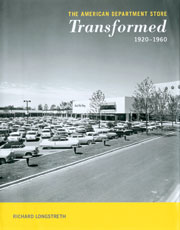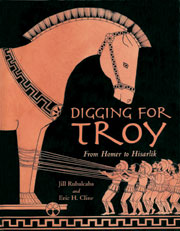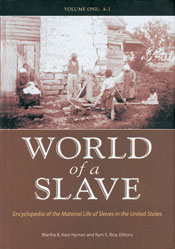Hot Shops
 It's not just shopaholics who have been affected by the ascension of the department store into a major urban landmark.
It's not just shopaholics who have been affected by the ascension of the department store into a major urban landmark.
In fact, department stores have evolved symbiotically with the modern city. Particularly in the first half of the 20th century, myriad influences—including the rise of the car and new paradigms of consumerism—shaped the architectural development of major stores like Marshall Field's and Wanamaker's as surely as they did those stores' home cities of Chicago and Philadelphia.
Richard Longstreth, American studies professor and director of the graduate program in historic preservation, addresses this new lens for viewing metropolitan architecture in his sweeping survey, The American Department Store Transformed: 1920-1960 (Yale University Press, 2010). By examining the architectural changes undergone by major department stores across the nation, Dr. Longstreth is able to study complex social issues from a unique perspective.
Take, for example, the emergence of the parking lot. Dr. Longstreth explains how this major architectural consideration is one example of the ways in which the department store served as a microcosm of the metropolitan landscape. The post-World War I boom in car ownership was a mixed blessing for the department store industry. As well-heeled consumers became increasingly inclined to drive, store developers found that the exponential increase in their institutions' size and capacity wasn't matched by a corresponding accessibility.
While the car brought in more customers from greater distances, it also forced designers to innovate: These potential customers, after all, were only of use to a store's owners if they could get out of their car and shop. The solutions devised to this problem—from rooftop parking to private garages to valet service—affected, and were affected by, the evolution of the midcentury "downtown."
Sing, Muse, of the Historical Record
 Homer's Iliad is a cornerstone of Western literature: The affair of Trojan prince Paris and married Greek beauty Helen, and its devastating consequences, have inspired artists from Shakespeare (Troilus and Cressida) to Brad Pitt (a regrettable turn as the warrior Achilles in the film Troy). The Trojan epic also has an enduring power over the imaginations of scholars and archaeologists, who have in modern times invested much in determining Troy's historical antecedents.
Homer's Iliad is a cornerstone of Western literature: The affair of Trojan prince Paris and married Greek beauty Helen, and its devastating consequences, have inspired artists from Shakespeare (Troilus and Cressida) to Brad Pitt (a regrettable turn as the warrior Achilles in the film Troy). The Trojan epic also has an enduring power over the imaginations of scholars and archaeologists, who have in modern times invested much in determining Troy's historical antecedents.
At Hisarlik, a site in western Turkey, many believe it has been found. In Digging for Troy: From Homer to Hisarlik (Charlesbridge, 2011), Eric H. Cline, chair of the Department of Classical and Near Eastern Languages and Civilizations, co-writing with Jill Rubalcaba, tells the story of the parade of eccentrics and intellectuals who have sought Homer's Troy at Hisarlik.
Dr. Cline and Dr. Rubalcaba focus on the quest to determine whether the Trojan War as Homer described it ever actually occurred—and, if it did, whether Hisarlik might really have been its site.
The people to seek Troy's remains there have been as varied, and as controversial, as their theories. Nineteenth-century entrepreneur Heinrich Schliemann, the first character Dr. Cline and Dr. Rubalcaba discuss, was an enthusiastic—and, by modern standards, inept—amateur. He plowed carelessly through layers of priceless artifacts and ruins, kept imperfect records, and twisted his findings to suit his predetermined narrative. (Mr. Schliemann was resolved, for example, to pass off finds of early Bronze Age jewelry—remarkable in their own right—as "the treasure of Helen," despite being at least a thousand years older than the historical Helen could have been.)
He did, however, make discoveries on which later, more proficient expeditions could build. Archaeologist Carl Blegen was able to refine Hisarlik's layers of structure into a timeline of nine Trojan settlements, one of which he believed showed signs of having undergone a devastating siege. Modern expeditions, like those led by German archaeologist Manfred Korfmann from the late '80s until his death in 2005, have been more ambivalent about the idea of a historical Trojan War. One thing all of these Hisarlik explorers have in common: an inability to resist the allure of the Homeric epic.
The Things They Carried
 When it comes to reconstructing lost worlds, the slave-owning South—while less distant in time than ancient Troy—is, for many, equally unimaginable. World of a Slave: Encyclopedia of the Material Life of Slaves in the United States, is a two-volume encyclopedia intended to evoke, and honor, the "material culture" of enslaved life: the everyday objects, structures, and foods that gave shape and context to a slave's day-to-day experience.
When it comes to reconstructing lost worlds, the slave-owning South—while less distant in time than ancient Troy—is, for many, equally unimaginable. World of a Slave: Encyclopedia of the Material Life of Slaves in the United States, is a two-volume encyclopedia intended to evoke, and honor, the "material culture" of enslaved life: the everyday objects, structures, and foods that gave shape and context to a slave's day-to-day experience.
As co-editor Kym Rice, director of GW's museum studies program, writes in the book's preface, little attention has been paid to the material aspect of slaves' lives. "Little tangible evidence" was thought to exist, and the documentary record "almost entirely [reflected] the slave-owners' perspective." The aim of World of a Slave, then, is to "use objects as a prism for understanding both the complex institution that was American slavery and the individual experiences of the people trapped within it."
The result is an unusually intimate and evocative catalog. Through meticulously researched entries by renowned scholars in the field, Dr. Rice and her co-editor, Martha B. Katz-Hyman, detail the quotidian objects that affected the shape of a slave's life, from the structures in which they lived and worked, to the food they ate and the dishes they ate from, to spiritual and cultural artifacts like the religious cosmograms found carved into many slave quarters. World of a Slave refuses to treat slavery as a monolithic institution; rather, it lets the things with which slaves surrounded themselves help to tell the stories of their lives. In so doing, it restores some degree of dignity to an otherwise impersonal historical record.
—Ruth Steinhardt
